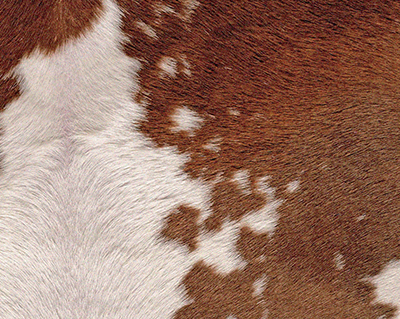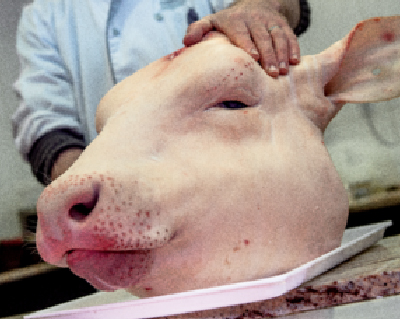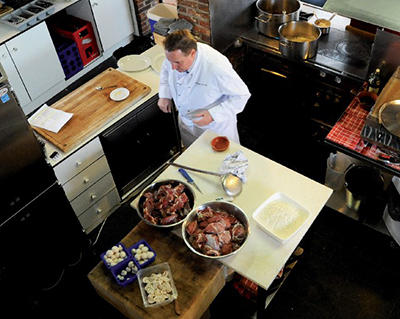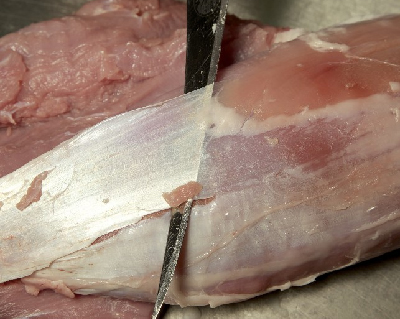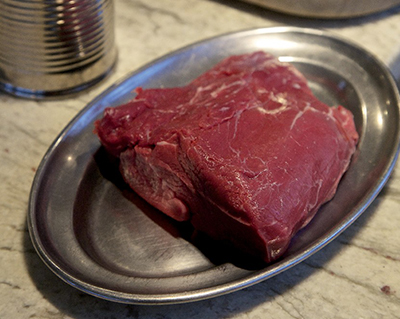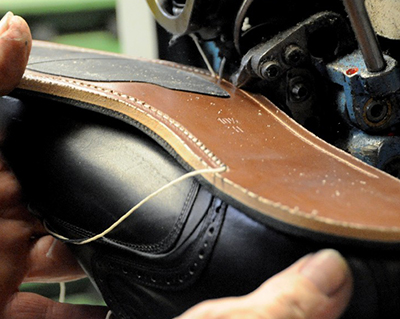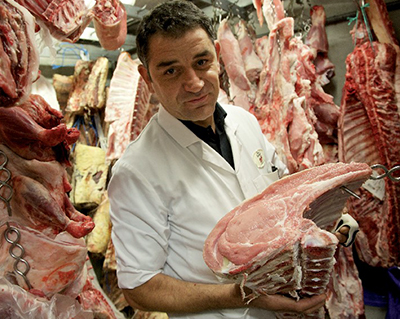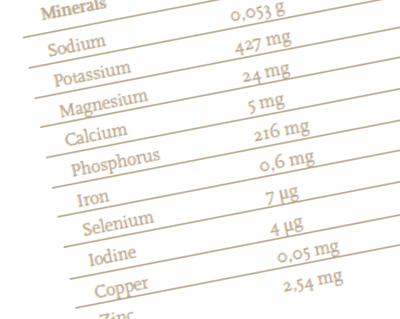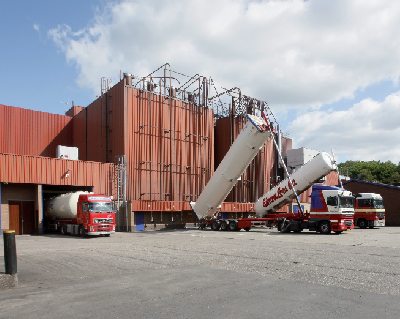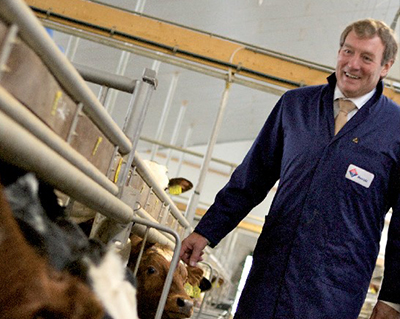A remarkable individual within the veal sector in Belgium is Jos Theys. Born in 1947 and son of a veal wholesaler, Jos soon became bored with school and decided to follow in the footsteps of his eldest brother who was a butcher. At the age of fourteen, he became apprenticed to an old-fashioned butcher who made all of his own produce. This meant spending two half-days at school and five days at work. When he turned eighteen, he joined his father’s business whilst waiting to be drafted into military service.
Things were different back then. Everything revolved around the cattle market in Brussels, where live calves were brought for sale every Thursday. After the market floor had been hosed down with water, it was the slaughtered calves’ turn. Principles like HACCP were unheard of. All that was required, was a trestle table which you could hire in the same way as the other 70 small traders did. Jos’s father worked on his own and sold about 20 calves every week. He reared them the old-fashioned way, fed them milk and eggs for 10 weeks and then sold them at dressed weights of about 85-90 kilos.
This was an acceptable top weight and anything over 100 kilos went unsold.
8After his time as a cook in the military, Jos decided to start his own business. This was just as the veal industry was starting to emerge, so he bought a supply of the newly- invented milk replacer and 12 newborn calves. He reared the calves himself, which were good, dual-purpose breeds and later the first of the very reliable breed, the Belgian Blue. Their quality was apparent in the price. One of Jos’s newborn calves would sell for 2500 to 3000 francs, whilst a Holstein cost 500 to 1500. Jos fattened up his calves for fourteen weeks and produced dressed weights of 120 to 125 kilos, but why did he manage to sell his calves at such a high price, whilst others could not? The answer was his new approach to dressing which was different from anything seen at the meat market in Brussels before. Jos was the first person to cut the carcasses into wholesale and retail cuts, meaning that the butchers no longer needed to buy carcasses in halves or quarters, and he soon became an attractive supplier. Demand increased, and before long, Jos needed to buy in additional livestock. In order to measure the quality of his produce, he followed his father’s example and cut a piece off each carcass and took it home, where it was cooked and given the definitive taste test. This soon turned into a classifica- tion in its own right.
Then the time came when some were experimenting with hormones, even synthetic hormones, and the quality of meat started to suffer. Wessanen, a leading company in theEuropean organic and natural food market, was fed up with whole discussion and decided to relinquish its meat business. This presented Jos with an opportunity to take over the business for a token sum, which he did in 1970. He was determined to have full control of the operation and decided to slaughter his own animals at the municipal slaughterhouse in Hasselt, local to Wessanen. There was enough room for his calves too and Wessanen had promised him 100 new calves every week. Wessanen soon failed in its obligation and Jos went across the border to find new calves. When he got there, he discovered EKRO, a business in the Netherlands that later specialised in rearing veal calves in groups. The supply of carcasses from EKRO grew to 800 a week; a considerable proportion of their production at the time, and Jos delivered 100 calves a week for finishing from his own livestock. Needless to say, his production rate continued to increase at a rapid rate.
Collaboration with a number of producers of milk replacers ensued, and the numbers rocketed. Jos acquired the abattoir in Hasselt while he was already producing 1200 calves a week, but it was insufficient. Jos wanted more. He wanted to do things differently from everyone else and decided to set up his own laboratory. Can you imagine it? A veal producer with his own laboratory, full-equipped with gas chromatograph back in the early 1980s? Initially, the lab focused on fatty acid patterns, followed later by triglycerides. In addition to the laboratory, Jos opened a unique and extremely large, luxurious butcher’s shop in the centre of Hasselt that was dedicated to veal and named it Vealerie. “The company had grown enormously,” comments Jos. “We had a good sales concept, we were well organised, and our methodology meant that we were able to use every part of every calf. But we still weren’t making any money. At the end of the eighties, the newborn calf plus the milk replacer cost more than the price we made on the meat.”
Junior Beef
At that time, there was not a single restaurant in Belgium that sold Belgian beef. People were tired of all of the scandals, and the excessive use of clenbuterol had spoiled the tenderness of the tenderloin. Restaurant owners turned to South America where the beef was still pristine and Jos needed a solution. He launched a new project called Junior Beef. “All I could think about was which meat I wanted to produce,” he adds. “I looked closely at what the restaurants wanted. Which cuts, and how lean they should be. It had to be just right. That’s why I chose heifers for Junior Beef, and why I started thinking differently about their feed.” This is also why the price of Junior Beef was much higher, because it was (and is) a superior meat, specifically designed for restaurants.
In 1991 Jos sold his company, only to buy it back two years later in a management buyout. He had 36,000 calves and business was better than ever. The general situation had improved, but then the dioxin crisis hit Belgium like a thunderbolt. The whole scandal had nothing whatsoever to do with calves, it just affected chickens and pigs, but it had a suffocating hold on the Belgian meat market for a long time. The consumer stopped buying meat produced in Belgium and exports were banned. This was the final blow for Jos Theys, who was forced to sell his company for a second time.
The Farm
However, for Jos Theys, this is not the end of the story. He is still producing Junior Beef, albeit on a smaller scale on Jos Theys Farm, his next unique enterprise that he started in 1994. He now combines the rearing of veal calves with a restaurant specialising in Junior Beef. The guests can see the animals from their tables in open stalls. Children can pet the animals and for anyone who is interested, there is always an enthusiastic story to be told about the ins and outs of the production process.
The restaurant serves Junior Beef in a variety of dishes, and everything is made in house. There is a small shop adjacent to the restaurant where guests can buy their own cuts of meat to take home with them, and many a restaurant owner comes from far and wide to buy their veal here. It is difficult to believe, but nearly every single one of Jos’s 560 calves, each with a dressed weight of between 220 to 240 kilos, ends up in the restaurant’s kitchen. We have no doubt that the Jos Theys Farm will start breaking new records of its own, very soon.
www.jostheys.be


